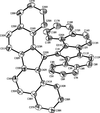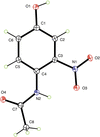issue contents
February 2022 issue

Cover illustration: Bis[1,2-bis(4-chlorophenyl)ethylene-1,2-dithiolato(1−)]nickel(II) crystallizes as pairs of molecules related by an inversion center at the bc face of the cell with close intermolecular C—H⋯S (2.884 Å) and C—H⋯Ni contacts (3.032 Å) that are less than the sum of the van der Waals radii and which appear to induce slight bowing of the molecular planes toward one another. The angles at which the four p-ClC6H4- rings join the NiS2C2 chelate rings [39.37 (9)– 53.41 (6)°] are similarly influenced by these intermolecular contacts. In the larger packing arrangement, sheets of molecules extend in the direction of the ac face diagonal. See: Koehne, Mirmelli, Mague & Donahue [IUCrData (2022). 7, x220148].
metal-organic compounds


 access
access

 access
access

 access
accessorganic compounds


 access
access

 access
access

 access
access

 access
access

 access
access

 access
access

 journal menu
journal menu




















![[publCIF]](/logos/authorchecklist11.gif)





